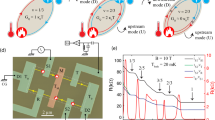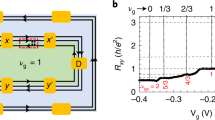Abstract
Thermal conductance measurements are sensitive to both charge and chargeless energy flow and are an essential measurement technique in condensed-matter physics. For two-dimensional topological insulators, the determination of thermal Hall (transverse) conductance and thermal longitudinal conductance is crucial for the understanding of topological order in the underlying state. Such measurements have not been accomplished, even in the extensively studied quantum Hall effect regime. Here we report a local power measurement technique that we use to reveal the topological thermal Hall conductance, going beyond the ubiquitous two-terminal conductance. For example, we show that the thermal Hall conductance is approximately zero in the v = 2/3 particle–hole conjugated state. This is in contrast to the two-terminal thermal conductance that gives a non-universal value that depends on the extent of thermal equilibration between the counter-propagating edge modes. Moreover, we demonstrate the utility of this technique in studying the power carried by the current fluctuations of a partitioned edge mode with an out-of-equilibrium distribution.
This is a preview of subscription content, access via your institution
Access options
Access Nature and 54 other Nature Portfolio journals
Get Nature+, our best-value online-access subscription
$29.99 / 30 days
cancel any time
Subscribe to this journal
Receive 12 print issues and online access
$209.00 per year
only $17.42 per issue
Buy this article
- Purchase on Springer Link
- Instant access to full article PDF
Prices may be subject to local taxes which are calculated during checkout




Similar content being viewed by others
Data availability
The raw noise measurements (and other) data generated and analysed during the current study are available from the corresponding author on reasonable request. Source data are provided with this paper.
References
Pekola, J. P. & Karimi, B. Colloquium: quantum heat transport in condensed matter systems. Rev. Mod. Phys. 93, 041001 (2021).
Waissman, J. et al. Electronic thermal transport measurement in low-dimensional materials with graphene non-local noise thermometry. Nat. Nanotechnol. 17, 166–173 (2022).
Gomès, S., Assy, A. & Chapuis, P.-O. Scanning thermal microscopy: a review. Phys. Status Solidi A 212, 477–494 (2015).
Halbertal, D. et al. Nanoscale thermal imaging of dissipation in quantum systems. Nature 539, 407–410 (2016).
Halperin, B. I. Quantized Hall conductance, current-carrying edge states, and the existence of extended states in a two-dimensional disordered potential. Phys. Rev. B 25, 2185–2190 (1982).
Wen, X.-G. Quantum Field Theory of Many-Body Systems: From the Origin of Sound to an Origin of Light and Electrons (Oxford Univ. Press, 2004).
Kane, C. L. & Mele, E. J. Quantum spin Hall effect in graphene. Phys. Rev. Lett. 95, 226801 (2005).
Wen, X. G. Gapless boundary excitations in the quantum Hall states and in the chiral spin states. Phys. Rev. B: Condens. Matter 43, 11025–11036 (1991).
Wen, X.-G. Topological orders and edge excitations in fractional quantum Hall states. Adv. Phys. 44, 405–473 (1995).
Kane, C. L. & Fisher, M. P. A. Quantized thermal transport in the fractional quantum Hall effect. Phys. Rev. B 55, 15832–15837 (1997).
Read, N. & Green, D. Paired states of fermions in two dimensions with breaking of parity and time-reversal symmetries and the fractional quantum Hall effect. Phys. Rev. B 61, 10267–10297 (2000).
Senthil, T. & Fisher, M. P. A. Quasiparticle localization in superconductors with spin-orbit scattering. Phys. Rev. B 61, 9690–9698 (2000).
Cappelli, A., Huerta, M. & Zemba, G. R. Thermal transport in chiral conformal theories and hierarchical quantum Hall states. Nucl. Phys. B 636, 568–582 (2002).
Jezouin, S. et al. Quantum limit of heat flow across a single electronic channel. Science 342, 601–604 (2013).
Banerjee, M. et al. Observed quantization of anyonic heat flow. Nature 545, 75–79 (2017).
Banerjee, M. et al. Observation of half-integer thermal Hall conductance. Nature 559, 205–210 (2018).
Srivastav, S. K. et al. Universal quantized thermal conductance in graphene. Sci. Adv. 5, eaaw5798 (2019).
Srivastav, S. K. et al. Vanishing thermal equilibration for hole-conjugate fractional quantum Hall states in graphene. Phys. Rev. Lett. 126, 216803 (2021).
Melcer, R. A. et al. Absent thermal equilibration on fractional quantum Hall edges over macroscopic scale. Nat. Commun. 13, 376 (2022).
Aharon-Steinberg, A., Oreg, Y. & Stern, A. Phenomenological theory of heat transport in the fractional quantum Hall effect. Phys. Rev. B 99, 041302 (2019).
Bid, A. et al. Observation of neutral modes in the fractional quantum Hall regime. Nature 466, 585–590 (2010).
Venkatachalam, V., Hart, S., Pfeiffer, L., West, K. & Yacoby, A. Local thermometry of neutral modes on the quantum Hall edge. Nat. Phys. 8, 676–681 (2012).
Lafont, F., Rosenblatt, A., Heiblum, M. & Umansky, V. Counter-propagating charge transport in the quantum Hall effect regime. Science 363, 54–57 (2019).
Kane, C. L., Fisher, M. P. & Polchinski, J. Randomness at the edge: theory of quantum Hall transport at filling ν = 2/3. Phys. Rev. Lett. 72, 4129–4132 (1994).
Kane, C. L. & Fisher, M. P. A. Impurity scattering and transport of fractional quantum Hall edge states. Phys. Rev. B 51, 13449–13466 (1995).
Sivre, E. et al. Electronic heat flow and thermal shot noise in quantum circuits. Nat. Commun. 10, 5638 (2019).
Rosenblatt, A. et al. Energy relaxation in edge modes in the quantum Hall effect. Phys. Rev. Lett. 125, 256803 (2020).
Kumar, R. et al. Observation of ballistic upstream modes at fractional quantum Hall edges of graphene. Nat. Commun. 13, 213 (2022).
Johnson, J. B. Thermal agitation of electricity in conductors. Phys. Rev. 32, 97–109 (1928).
Nyquist, H. Thermal agitation of electric charge in conductors. Phys. Rev. 32, 110–113 (1928).
Altimiras, C. et al. Non-equilibrium edge-channel spectroscopy in the integer quantum Hall regime. Nat. Phys. 6, 34–39 (2010).
Pothier, H., Guéron, S., Birge, N. O., Esteve, D. & Devoret, M. H. Energy distribution function of quasiparticles in mesoscopic wires. Phys. Rev. Lett. 79, 3490–3493 (1997).
Martin, T. & Landauer, R. Wave-packet approach to noise in multichannel mesoscopic systems. Phys. Rev. B 45, 1742–1755 (1992).
Buttiker, M. Scattering theory of current and intensity noise correlations in conductors and wave guides. Phys. Rev. B: Condens. Matter 46, 12485–12507 (1992).
le Sueur, H. et al. Energy relaxation in the integer quantum Hall regime. Phys. Rev. Lett. 105, 056803 (2010).
Bhattacharyya, R., Banerjee, M., Heiblum, M., Mahalu, D. & Umansky, V. Melting of interference in the fractional quantum Hall effect: appearance of neutral modes. Phys. Rev. Lett. 122, 246801 (2019).
Neder, I., Marquardt, F., Heiblum, M., Mahalu, D. & Umansky, V. Controlled dephasing of electrons by non-Gaussian shot noise. Nat. Phys. 3, 534–537 (2007).
Sivre, E. et al. Heat Coulomb blockade of one ballistic channel. Nat. Phys. 14, 145–148 (2018).
Acknowledgements
We acknowledge C. Spånslätt, J. Park, A. D. Mirlin and K. Snizhko for useful discussions. M.H. acknowledges the continuous support of the Sub-Micron Center staff, the support of the European Research Council under the European Community’s Seventh Framework Program (FP7/2007-2013)/ERC under grant agreement number 713351 and the partial support of the Minerva foundation under grant number 713534.
Author information
Authors and Affiliations
Contributions
R.A.M. and S.K. fabricated the devices, performed the measurements and analysed the data. M.H. supervised the experiment and the analysis. V.U. grew the GaAs heterostructures. All authors contributed to the writing of the manuscript.
Corresponding author
Ethics declarations
Competing interests
The authors declare no competing interests.
Peer review
Peer review information
Nature Physics thanks Francois Parmentier and the other, anonymous, reviewer(s) for their contribution to the peer review of this work.
Additional information
Publisher’s note Springer Nature remains neutral with regard to jurisdictional claims in published maps and institutional affiliations.
Supplementary information
Supplementary Information
Supplementary Sections 1–8, Figs. 1–5 and Table 1.
Source data
Source Data Fig. 2
Statistical source data for Fig. 2d.
Source Data Fig. 3
Statistical source data for Fig. 3c.
Source Data Fig. 4
Statistical source data for Fig. 4e,f.
Rights and permissions
Springer Nature or its licensor (e.g. a society or other partner) holds exclusive rights to this article under a publishing agreement with the author(s) or other rightsholder(s); author self-archiving of the accepted manuscript version of this article is solely governed by the terms of such publishing agreement and applicable law.
About this article
Cite this article
Melcer, R.A., Konyzheva, S., Heiblum, M. et al. Direct determination of the topological thermal conductance via local power measurement. Nat. Phys. 19, 327–332 (2023). https://doi.org/10.1038/s41567-022-01885-5
Received:
Accepted:
Published:
Issue Date:
DOI: https://doi.org/10.1038/s41567-022-01885-5
This article is cited by
-
Heat conductance of the quantum Hall bulk
Nature (2024)



